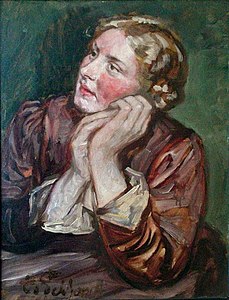Eduard von Gebhardt
show This article may be expanded with text translated from the corresponding article in German. (August 2021) Click [show] for important translation instructions. |
Eduard von Gebhardt | |
|---|---|
 Eduard von Gebhardt, photo | |
| Born | 13 June 1838 |
| Died | 3 February 1925 (aged 86) |
| Nationality | Baltic German |
Franz Karl Eduard von Gebhardt (13 June 1838 – 3 February 1925) was a Baltic German historical painter. He was born in Järva-Jaani, Estonia, the son of a Protestant clergyman, and studied first at the Academy of St. Petersburg (1855–58). In 1860 he became the pupil of Wilhelm Sohn at Düsseldorf, where he permanently settled, and became professor at the academy in 1873. One of his students was the German-Brazilian painter .
There is a religious tone defining many of his most highly regarded paintings. Their chief characteristic is their deep and powerful yet varied expression of religious feeling. The more important among the many biblical scenes he painted are:
- "Christ on the Cross" (1866, St Mary's Cathedral, Tallinn)
- "The Last Supper" (1870, National Gallery, Berlin)
- "Crucifixion" (1873, Hamburg Kunsthalle)
- "Ascension of Christ" (1881, National Gallery, Berlin)
- "Taking Care of Christ's Body" (1883, Dresden Gallery)
- "Jacob and the Angel" (1893, Dresden Gallery)
- "Christ and the Rich Youth" (1892, Düsseldorf Gallery)
- "Sermon on the Mount" (1893, Düsseldorf Gallery)
- "Healing of the Palsied" (1895, Breslau Museum)
- "Christ upon the Waters" (1902)
Of episodes from the Reformation one is "The Reformer at Work" (1877, Leipzig Museum). In the former Cistercian monastery at Lokkum may be seen six mural paintings: "Scenes from the Life of Christ". Mural paintings of similar subjects may be found at the Friedenskirche, Düsseldorf.
Gebhardt also painted many excellent portraits, and was awarded gold medals at Berlin, Dresden, Munich, Vienna, and Paris; and was elected a member of the academies of Antwerp, Berlin, Brussels, Munich, and Vienna. He died in 1925.
He took prototypes of local peasants which he draw down while visiting Estonia. He was a tutor to famous Estonian painters like Ants Laikmaa, Kristjan and Paul Raud.
Gallery[]

Estonian Peasant (1867)

Rich man and poor Lazarus (1865)

The Raising of Lazarus (1896)

Portrait of a Woman (date unknown)
See also[]
- List of Baltic German artists
- List of German painters
References[]
This article incorporates text from a publication now in the public domain: Gilman, D. C.; Peck, H. T.; Colby, F. M., eds. (1905). New International Encyclopedia (1st ed.). New York: Dodd, Mead. Missing or empty |title= (help)
| Wikimedia Commons has media related to Eduard von Gebhardt. |
- 1838 births
- 1925 deaths
- People from Järva Parish
- People from the Governorate of Estonia
- Baltic-German people
- 19th-century German painters
- German male painters
- 20th-century German painters
- 20th-century male artists
- 19th-century Estonian painters
- Emigrants from the Russian Empire to Germany
- Recipients of the Pour le Mérite (civil class)
- 19th-century male artists
- German painter stubs
- Estonian people stubs
- European painter stubs




